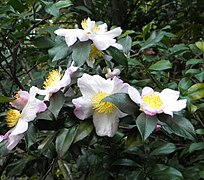(Z)-3-Hexenolprimverosid
| Strukturformel | |||||||||||||
|---|---|---|---|---|---|---|---|---|---|---|---|---|---|

| |||||||||||||
| Allgemeines | |||||||||||||
| Name | (Z)-3-Hexenolprimverosid | ||||||||||||
| Andere Namen |
| ||||||||||||
| Summenformel | C17H30O10 | ||||||||||||
| Externe Identifikatoren/Datenbanken | |||||||||||||
| |||||||||||||
| Eigenschaften | |||||||||||||
| Molare Masse | 394,4 g·mol−1 | ||||||||||||
| Sicherheitshinweise | |||||||||||||
| |||||||||||||
| Soweit möglich und gebräuchlich, werden SI-Einheiten verwendet. Wenn nicht anders vermerkt, gelten die angegebenen Daten bei Standardbedingungen (0 °C, 1000 hPa). | |||||||||||||
(Z)-3-Hexenolprimverosid ist ein natürlich vorkommendes Glycosid aus β-D-Primverose und (Z)-3-Hexenol.
Vorkommen
[Bearbeiten | Quelltext bearbeiten](Z)-3-Hexenolprimverosid ist neben Benzylprimverosid, Phenethylprimverosid, Linalylprimverosid und Geranylprimverosid Bestandteil des Aromas von Tee.[2][3][4] Daneben kommt es auch in dem Hundsgiftgewächs Apocynum venetum[5] vor. Verschiedene Arten der Gattung Alangium aus der Familie der Hartriegelgewächse, darunter Alangium platanifolium[6] und Alangium chinense[7], enthalten ebenfalls (Z)-3-Hexenolprimverosid.
-
Teepflanze
-
Apocynum venetum
-
Alangium chinense
Biosynthese
[Bearbeiten | Quelltext bearbeiten]Die Biosynthese in Teepflanzen wurde untersucht. Dabei findet eine zweistufige Glycosylierung statt, zuerst mit Glucose, dann mit Xylose. Eine Glycosyltransferase bildet Glucoside von verschiedenen Alkoholen (neben (Z)-3-Hexenol auch 2-Phenylethanol, Linalool und Benzylalkohol). Eine zweite kann dann spezifisch diese Glucoside durch Übertragung von Xylose in Primveroside überführen.[4]
Synthese
[Bearbeiten | Quelltext bearbeiten]Mittels Umglycosylierung des Primverosids von p-Nitrophenol mittels Penicillium multicolor können diverse andere Primveroside, darunter auch (Z)-3-Hexenolprimverosid im Millimol-Maßstab hergestellt werden.[8]
Einzelnachweise
[Bearbeiten | Quelltext bearbeiten]- ↑ Dieser Stoff wurde in Bezug auf seine Gefährlichkeit entweder noch nicht eingestuft oder eine verlässliche und zitierfähige Quelle hierzu wurde noch nicht gefunden.
- ↑ Dongmei Wang, Eriko Kurasawa, Yuichi Yamaguchi, Kikue Kubota, Akio Kobayashi: Analysis of Glycosidically Bound Aroma Precursors in Tea Leaves. 2. Changes in Glycoside Contents and Glycosidase Activities in Tea Leaves during the Black Tea Manufacturing Process. In: Journal of Agricultural and Food Chemistry. Band 49, Nr. 4, 1. April 2001, S. 1900–1903, doi:10.1021/jf001077+.
- ↑ Dongmei Wang, Takako Yoshimura, Kikue Kubota, Akio Kobayashi: Analysis of Glycosidically Bound Aroma Precursors in Tea Leaves. 1. Qualitative and Quantitative Analyses of Glycosides with Aglycons as Aroma Compounds. In: Journal of Agricultural and Food Chemistry. Band 48, Nr. 11, 1. November 2000, S. 5411–5418, doi:10.1021/jf000443m.
- ↑ a b Shoji Ohgami, Eiichiro Ono, Manabu Horikawa, Jun Murata, Koujirou Totsuka, Hiromi Toyonaga, Yukie Ohba, Hideo Dohra, Tatsuo Asai, Kenji Matsui, Masaharu Mizutani, Naoharu Watanabe, Toshiyuki Ohnishi: Volatile Glycosylation in Tea Plants: Sequential Glycosylations for the Biosynthesis of Aroma β -Primeverosides Are Catalyzed by Two Camellia sinensis Glycosyltransferases. In: Plant Physiology. Band 168, Nr. 2, Juni 2015, S. 464–477, doi:10.1104/pp.15.00403, PMID 25922059, PMC 4453793 (freier Volltext).
- ↑ Toshiyuki Murakami, Akinobu Kishi, Hisashi Matsuda, Masao Hattori, Masayuki Yoshikawa: Medicinal Foodstuffs. XXIV. Chemical Constituents of the Processed Leaves of Apocynum venetum L.: Absolute Stereostructures of Apocynosides I and II. In: Chemical and Pharmaceutical Bulletin. Band 49, Nr. 7, 2001, S. 845–848, doi:10.1248/cpb.49.845.
- ↑ Hideaki Otsuka, Yasuyuki Takeda, Kazuo Yamasaki: Xyloglucosides of benzyl and phenethyl alcohols and Z-hex-3-en-1-ol from leaves of Alangium platanifolium var. trilobum. In: Phytochemistry. Band 29, Nr. 11, Januar 1990, S. 3681–3683, doi:10.1016/0031-9422(90)85306-Z.
- ↑ Atsuko Itoh, Takao Tanahashi, Naotaka Nagakura, Kenichiro Inoue, Hiroshi Kuwajima, Hua-Xin Wu: Glycosides of Benzyl and Salicyl Alcohols from Alangium chinense. In: Chemical and Pharmaceutical Bulletin. Band 49, Nr. 10, 2001, S. 1343–1345, doi:10.1248/cpb.49.1343.
- ↑ Kazutaka Tsuruhami, Shigeharu Mori, Kanzo Sakata, Satoshi Amarume, Shigetaka Saruwatari, Takeomi Murata, Taichi Usui: Efficient Synthesis of β‐Primeverosides as Aroma Precursors by Transglycosylation of β‐Diglycosidase from Penicillium multicolor. In: Journal of Carbohydrate Chemistry. Band 24, Nr. 8-9, 1. November 2005, S. 849–863, doi:10.1080/07328300500439413.


